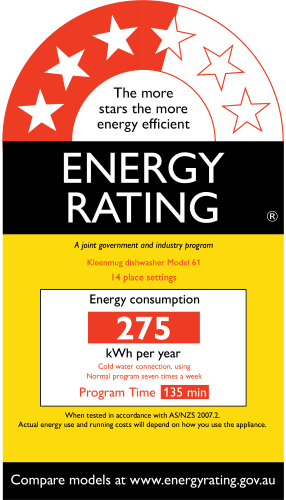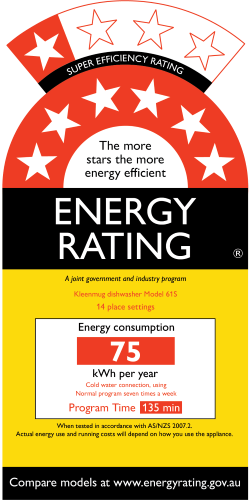For Consumers
Dishwashers

Dishwashers
Dishwashers have become a modern convenience that many households cannot live without. They can save time, but consume electricity and water, adding to household bills.
Choosing your dishwasher carefully and using it carefully will help you reduce your energy costs and environmental footprint.
Household dishwashers need to:
- meet Minimum Energy Performance Standards.
- display an Energy Rating Label.
The Energy Rating Label
The more stars, the more savings.
The Energy Rating Label helps you make informed choices when buying a dishwasher. It provides 3 important pieces of information about the appliance:
- star rating
- estimated annual energy consumption
- ‘Program Time’.
The star rating shows the energy efficiency of an appliance. It allows you to compare of the efficiency of products that have similar capacity and features. The more stars, the less energy it uses and the cheaper it is to run.
The energy consumption tells you the estimated amount of electricity the appliance can use in a year. This helps you predict the running costs, and assumes you use your appliance 7 times a week.
The ‘Program Time’ relates to the program used to test the model’s energy performance. It is the time, in minutes, the dishwasher takes to complete that program cycle.
It must also display the:
- brand
- model of the dishwasher
- rated capacity, which is the number of place settings that can be loaded in the dishwasher. One place setting equates to a large plate, a soup bowl, dessert bowl, a cup and saucer, a glass and a set of cutlery.
- primary water connection, which is the connection used for the energy labelling calculation
- program name, which is what the program used to calculate the estimated annual energy consumption. It is assumed that dishwashers are used 7 times a week.
Know your labels
This is the new Energy Rating Label which is being phased in from 4 October 2024. This label is only used on models that have a 6-star (or below) rating.

The new super-efficient Energy Rating Label is being phased in from 4 October 2024. This is used for models that meet or beat a 7-star rating.

This is the older Energy Rating Label which you may see on some appliances up to 3 October 2030 when they will be phased out.

How to choose the right dishwasher for you
-
Start with the size, capacity or place settings
When purchasing a dishwasher, the first step is to determine the size that will best meet your needs.
Larger families or regular entertainers need more capacity. While couples or singles are better suited to smaller appliances. Remember buying bigger is not always better. Larger machines use more electricity and more water, which means they cost you more money in the long run.
Place settings is a term used by industry to determine the capacity of a dishwasher.
One place setting equates to a large plate, a soup bowl, a dessert bowl, a cup and saucer, a glass and a set of cutlery.
Although larger units are available, there are generally 3 place setting categories:
- full-sized, 12 to 15 place settings
- slimline, 9 to 10 place settings
- compact, up to 8 place settings, which can include benchtop dish washers.
-
Consider the physical size of the dishwasher
Make sure you always measure the cavity or the physical space that you have for a new appliance. It could save you the hassle of cancelling your purchase or needing to return an item after it has been delivered.
-
Use the star rating to compare energy efficiency
It is important to compare products of the same capacity.
You can use the star ratings on the Energy Rating Label to compare the energy efficiency of similar sized appliances.
The star rating considers the capacity of the appliance. For example, a dishwasher that holds 10 place settings and has a 5-star energy rating will use more energy than a 5-star dishwasher that holds 6 place settings.
-
How will your dishwasher connect to the water outlet in your home?
Find out if the dishwasher you are considering heats water internally or relies on a hot/cold water, or a mixer connection. This may determine the type of dishwasher you choose.
Be aware that newer buildings often have different water connections to older buildings.
Water Rating Label
Dishwashers must display a Water Rating Label, under the Water Efficiency Labelling and Standards scheme.
The scheme was established in 2005 to encourage more efficient domestic water use and reduce demand for drinking water in Australia by informing consumers about water efficiency. It regulates taps, showers, toilets, urinals, flow controllers, dishwashers and washing machines.
Visit the Water Rating site for more information
Tips for using your dishwasher
-
Save energy and money while washing your dishes
You can save energy and money by:
- scraping off leftover food and rinsing or wiping off heavily soiled items, instead of pre-rinsing your dishes and cutlery in the sink
- always washing a full load, during off peak electricity times. Many households only run their dishwasher every second or third day.
- using a setting that will wash at around 50 degrees (usually the low to medium heat setting)
- allowing your dishes and cutlery to air-dry. To do this, turn off the heat-dry setting or open the door after the wash is complete and turn the machine off.
The modern dishwasher is an effective and energy efficient way to wash your dishes and cutlery. It also
- uses less water and energy than hand washing the equivalent number of dishes and cutlery
- operates at hot temperatures which are better for washing, rinsing and sanitising
- offers a range of energy saving program options, so follow the manufacturer’s recommendations to save money and energy to meet your dishwashing needs.
Additional resources

Visit Your Home which provides information on designing new homes and home improvements. There is a dedicated Reducing water use section, that provides information about dishwashers and more.

